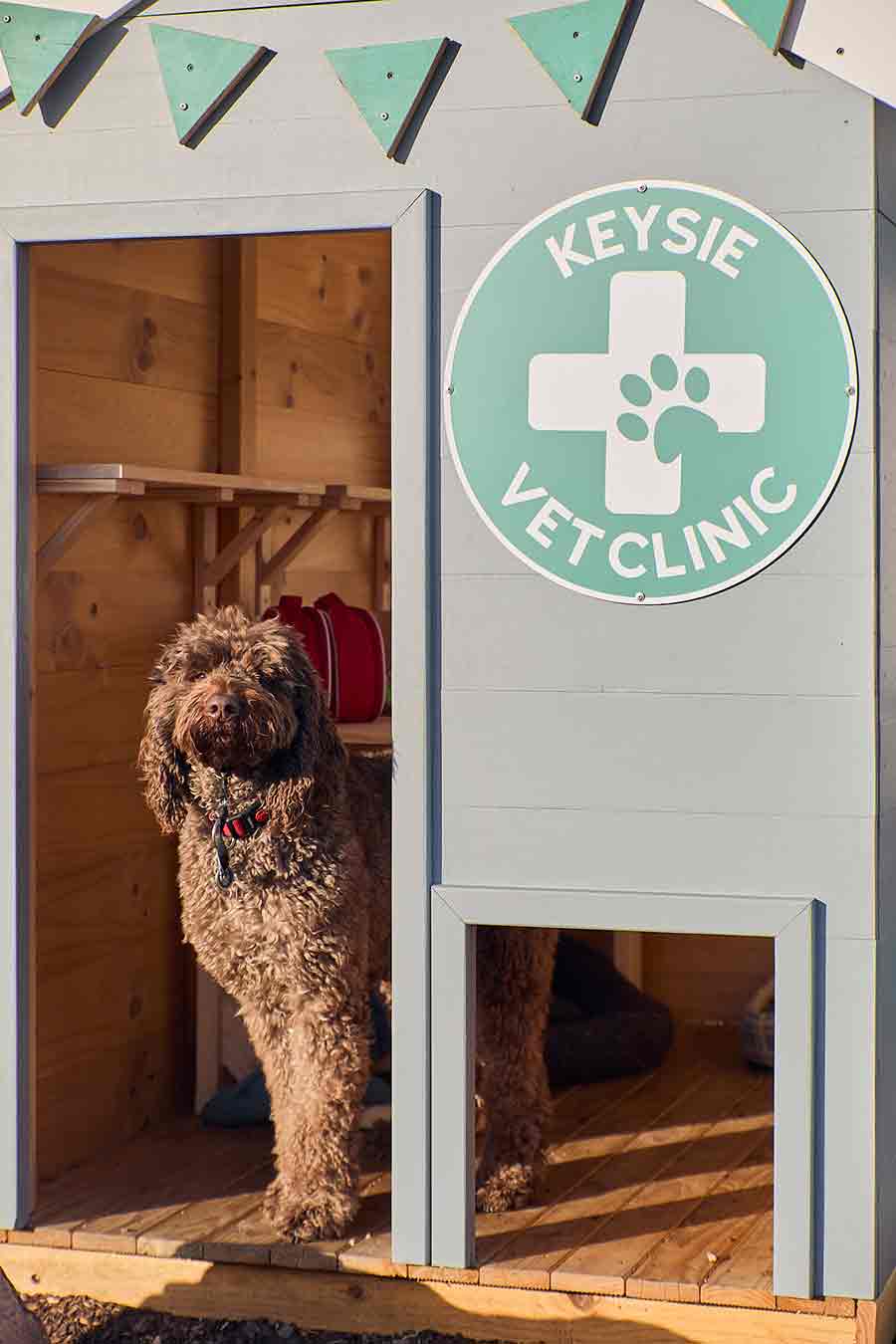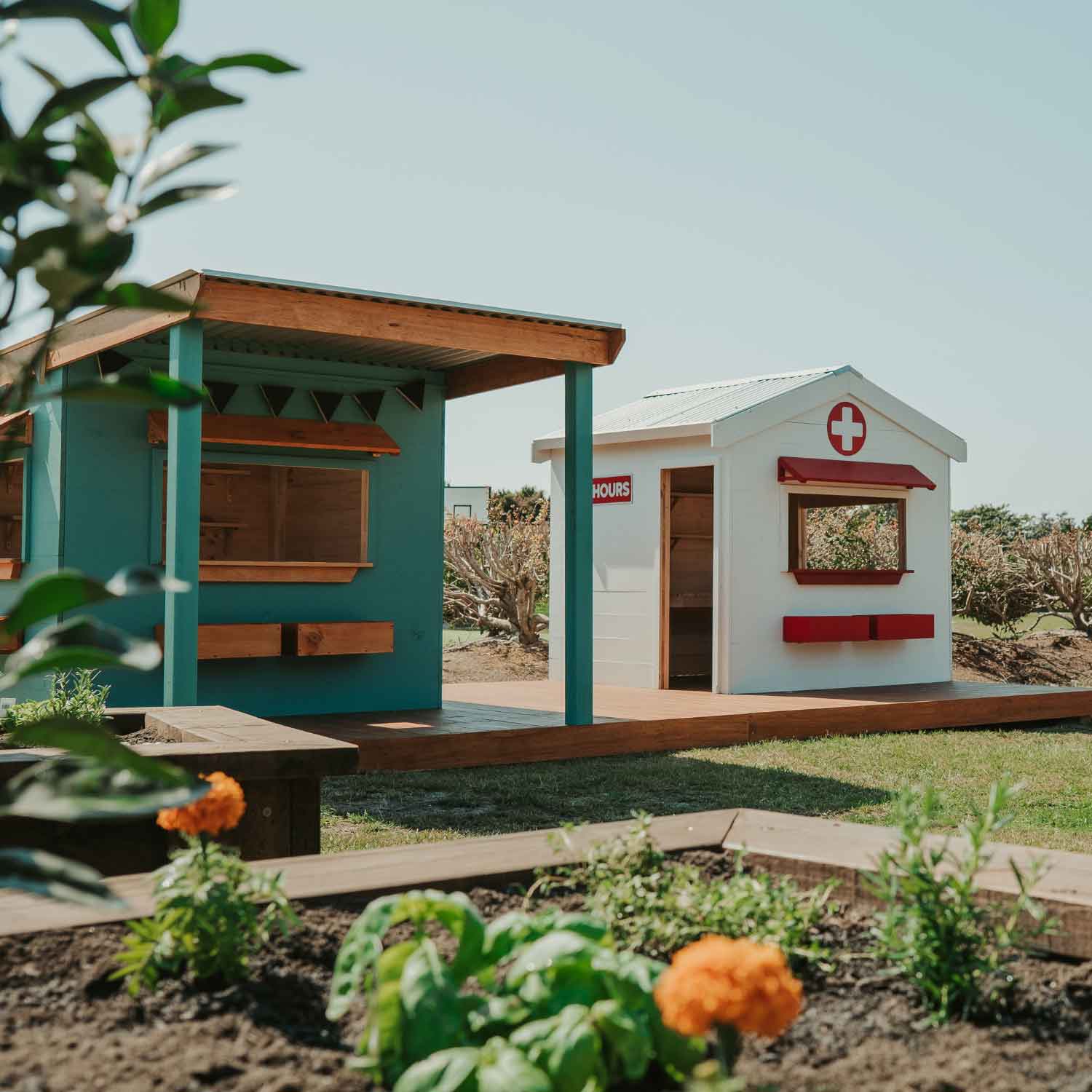Buddy doesn’t wear a uniform, and he certainly doesn’t follow the school bell — but to the students at Keysborough Primary School, he’s one of the most important members of their learning community. A Golden Labradoodle with a calm temperament and a heart full of patience, Buddy is the school’s wellbeing dog, and the unofficial mayor of the Keysie Village play space.
 |
 |
Part of a bigger vision of play-based learning
From the start, Buddy was part of a bigger vision. Keysie Village, a purpose-built outdoor play village, was created to offer more than just a break between lessons.
“We wanted a space that invited imagination, connection and calm,” explains Principal Sherri Jenkins. “Somewhere for rich, purposeful play — especially for students who find traditional playgrounds overstimulating.”
The design of the village includes a café, post office, fire station, and most famously, a veterinary clinic. That vet cubby was designed with Buddy in mind. “He was already a source of comfort to many students,” Sherri says. “We knew if we could create a space where children could care for him through role play, we'd be embedding wellbeing into the very structure of play.
The Power of Vet Play: Where Imagination Becomes Empathy
Vet play isn’t just make-believe — it’s one of the most powerful ways children learn.
When children step into imagined roles — especially caring ones like “the vet” — they’re doing far more than pretending. They’re learning to read emotions, communicate with purpose, and manage their own feelings along the way.
Psychologist Lev Vygotsky called play the foundation of development — a safe space where children practise empathy, planning, and problem-solving long before they can explain it. Researcher Sara Smilansky found the same: children who dive deep into imaginative play build stronger language, self-control, and social skills.
And when imagination meets compassion, something special happens. Caring for a “sick puppy” or calming a nervous toy cat helps children learn to nurture, comfort, and connect.
It’s more than play — it’s the beginning of emotional intelligence, built one gentle check-up at a time.

 |
 |
Learning Through Care
What makes the vet cubby so special isn’t just the pretending — it’s that the care is real.
Children aren’t imagining kindness; they’re practising it. They’re learning that empathy has action — that comfort, connection, and responsibility can be created with their own hands.
Studies on animal-assisted learning show that being around calm, trusted animals helps children reduce stress, communicate more openly, and feel safe to express emotion. In schools, therapy dogs have been shown to improve focus, confidence, and emotional regulation — especially for students who find traditional settings challenging.
When that real connection meets imaginative play, the impact doubles. Calm for the heart. Challenge for the mind. And in that playful caring — growth happens naturally.
A Calm Presence in a Busy World
On most days, you’ll find Buddy stretched out near the vet cubby, eyes half closed, as students chatter, write pretend appointment slips or gently stroke his fur. There’s a natural rhythm to the space — quiet but alive, soft but full of imagination.
“Buddy brings calm,” says Sherri. “He doesn’t ask anything of the students. He’s just there. That presence allows children to come as they are, without pressure.”
Teachers and support staff have noticed the transformation. One child with selective mutism began speaking during play while booking Buddy in for a ‘check-up’. Another student, previously withdrawn, took on the role of ‘head vet’, welcoming others into the game and leading imaginative narratives with confidence.
“It’s not structured intervention,” explains a classroom aide. “It’s play — but it’s deeply therapeutic.”
 |
 |
Sensory Support and Gentle Regulation
The vet cubby is equipped with weighted soft toy animals that can be used as props or comfort tools. For children who need help regulating, this becomes a powerful, non-verbal way to find calm. “Some children will come in, cradle a toy animal, and just sit quietly,” says Sherri. “There’s no expectation — just the invitation to feel safe.”
It’s also become a favoured space for small group work, transitions and one-on-one emotional support. “There’s no timetable or set session,” says one educator. “The village is available when it’s needed, and the children know they can find space there to reset.”

 |
 |
Learning In Action
Beyond wellbeing, the presence of Buddy has unlocked rich educational opportunities. Students write vet charts, design signage, and role-play everything from emergencies to adoption days. One Foundation class even hosted a birthday party for Buddy, complete with handmade invitations, decorations and a ‘menu’ of treats.
“We linked it all to literacy outcomes,” says a teacher. “But more than that, we saw real ownership and pride. The learning was meaningful because it came from them.”
Senior students in Years 5 and 6 are also involved as Play Leaders, helping to guide and support younger children through their games. They model inclusive play, set up the space for the day, and offer gentle encouragement. “They’re developing leadership skills through kindness,” says Sherri. “It’s beautiful to witness.”
 A special birthday party planned just for Buddy! |
 |
Buddy Beyond the Cubby
Buddy’s influence extends well beyond his designated vet cubby. He appears in drawings, is mentioned in writing tasks, and often features in social-emotional discussions. Children write him letters, check in on his wellbeing, and include him in their daily stories.
“He’s a constant,” says Sherri. “And for children who struggle with change or anxiety, that consistency matters.”
Teachers often use Buddy as a bridge to broader learning about empathy and school values. “We talk about how we care for Buddy,” says one Year 1 teacher, “and then we ask — how do we care for our friends in the same way?”
 |
 |
A Culture of Care
The success of the vet cubby — and Buddy’s central role within it — is a reflection of something deeper: a school culture rooted in inclusion, imagination, and emotional safety.
“We always say the village should feel like a real community,” says Sherri. “A place where children are seen, heard, and supported.”
Buddy helps to make that community real. Through his quiet presence, children learn to listen, to lead, and to care.
For Castle & Cubby, this story is a testament to what’s possible when play is designed with purpose. The vet cubby isn’t just a beautiful structure. It’s a bridge to connection. A safe harbour. A springboard for confidence.
And Buddy? He’s not just the dog in the village. He’s the heart of it.



